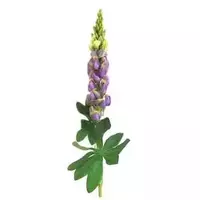Lupine

Externally, lupine is an annual or perennial herbaceous plant that belongs to the Legume family. It is characterized by a rod root system along with erect or creeping stems. The difficult-fingered leaves of lupine are held on long petioles.
In summer, lupin blooms quite attractively - its flowers are monochromatic or variegated, and for petals there is a sail-like shape. With the arrival of autumn, a free ovary forms on the plant, while a brown or black bean forms a little later, inside which seeds of various colors are contained.
One of the distinctive properties of lupine is the resistance of the plant to drought. Today, as many centuries ago, its main part is used as feed for livestock and fish. However, lupin is also used in many other areas - for example, in forestry, floriculture, bordering, as well as pharmacology and medicine.
In addition, in some countries lupin is popular in culinary affairs. In particular, residents of Australia and some European countries often prepare confectionery and bakery products based on flour made from white lupine. In South America, the plant's seeds are also added when cooking various dishes. For example, in Ecuador, Bolivia and Peru, lupin is highly valued - similar to potatoes and corn. German chefs often add lupin seeds to low-calorie ice cream, and the people of Indonesia and Japan use this product when preparing their traditional dishes - tofu, soy sauce and miso.
Lupine species
Of all the known lupine species, lupine white was the first to be cultured. So, initially, the inhabitants of Ancient Rome, Egypt and Greece became aware of its useful properties, where this plant was used as a medicine and food. In addition, not only soil fertilizer was made from lupine, but also nutritious food for animals.
Lupin benefits
The benefits of lupine are contained in its composition. It is from this plant that it is customary to extract very useful and valuable oil, which, in terms of efficiency and effect on the human body, can be put on a par with linseed and amaranth oils.
Lupin oil is a highly effective natural antioxidant. It is often used in the cosmetics industry. In addition, due to the high content of polyunsaturated fatty acids, it is advised to use it for diseases of the cardiovascular system.
Lupin harms
Speaking about the likely harm of lupin to human health, it is worth noting that it is observed only in the case of individual intolerance to components of plant origin in the composition of this product.
Lupine 0 kCal
Energy value of lupin (Ratio of proteins, fats, carbohydrates - ju):
Proteins: 0 g (~ 0 kCal)
Fats: 0 g (~ 0 kCal)
Carbohydrates: 0 g (~ 0 kCal)
 Español
Español Français
Français Português
Português Русский
Русский 简体中文
简体中文 繁體中文
繁體中文 日本語
日本語 한국어
한국어 العربية
العربية Türkçe
Türkçe Қазақ
Қазақ Deutsch
Deutsch Italiano
Italiano Українська
Українська
